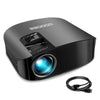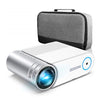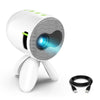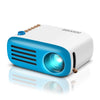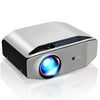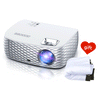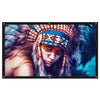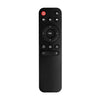
Projector Buying Guide: 8 Things to Consider Before Buying One
Has watching seasons on your television become boring? Does it feel dull to sit in front of a small television screen? Is it more thrilling to watch a movie at the cinema?
What if we told you that you could create a theater right at home? That's right!

Get a projector and bring that cinematic experience to every movie and show you watch. Projectors can also be useful in presenting at meetings, gaming with friends, reminiscing over old photos and videos with family, following workout videos, and whatnot.
Not only will it make everyday things more enjoyable, but a projector is portable, cheaper than a television of the same screen size, and compact enough to put on any table or shelf.
Sounds exciting, right?
However, do not rush into buying one right away. There are several essential things to know when buying a projector. With this extensive buyer’s guide, you will have your path paved to purchasing the perfect projector for your house.
Projector buying guide
To make the most out of your money, know the different types of projectors out there, and how their features differentiate. This will help you pick the one that suits you best. Here are five things to consider before buying one:
1. What kind of projector do I need?
Why do you need a projector to begin with? To answer this question, you need to know what a projector is and how it functions.
A projector throws light out of a lens onto a flat-screen to display images and videos. The transparent lens allows the light beams to pass through. These light beams can come from halide or LED sources.
You need to remember that projectors are best for visual representations such as watching or displaying media. However, note that it is not the best device for photo or video editing, color evaluation, or correcting media. If that’s what you plan, scratch buying a projector for it off your to-do list.
There are five major types of projectors; each one developed to suit a specific purpose. Let's dig in and decide which type will serve your purpose:
Multimedia projector
If you intend to use your projector frequently in presentations, meetings, classrooms, weddings, or slideshows, a small ad compact projector should be your go-to. A multimedia projector is best for this. One of the most widely-sold devices, a multimedia projector, is lightweight, portable, and easily connects to cable boxes. For example, VCRs and DVD players weigh less than 3lb mostly.

Mini Projector
If you are looking for portability, a mini projector should be your pick. This pocket projector can be carried anywhere with you replacing your computer or mini television. To further suit to its function, it uses LED lights to consume minimum power. Moreover, cooling technology prevents it from heating up, and you can use it for more extended periods.
Some great choices available include:
● Goodee YG220 Portable Mini Projector
This one is the size of your palm. While small and compact, it provides a high resolution of 1080p.
● Goodee YG200 Pico Mini Power Bank
This mini-projector has very efficient charging, and a built-in speaker makes it suitable for most locations.
Note that mini projectors do not have a zoom-in feature. Therefore, you will have to adjust your projector position to get your preferred size onto a screen. The adjustment will be comfortable keeping in view how small and easy-to-handle this one is.
Home Theater Projectors
True to their name, home theater projectors are an all-rounder. It pools high definition (HD) resolution, a screen size that can go up to 100 inches, high brightness, and vibrant colors to brew the perfect combination of features.
While the price is high, it is worth it. It has the most top zoom out there
● Goode YG601 Updated LCD Home Theater
This one is a powerful projector. Along with commendable clarity and brightness, it has a very effective cooling system. It makes no noise ensuring nothing affects your experience.
Short Throw/Ultra Short Throw Projectors (a subset of multimedia projectors)
This type of projector is for those who wish to set a projector up in a small, confined space. It can produce full images of up to 100 inches while being only 3 to 4 inches from the wall/screen. It is the perfect solution for smaller rooms.
However, some of its features are not as developed as those of other projectors. Most throw projectors do not have zoom lenses. I may not be too much of a problem since you will place it in a small room.
With a throw ratio of less than 1:1, it is mounted to a wall and not the ceiling.
Large-venue Projectors
Projectors give the best results in low brightness. So, in areas with inevitable light such as large theaters, churches, or halls, you need to use a large-venue projector. With a screen-size up to 100 inches, this is the one for the professionals.
To know where you want to place your projector, in what kind of lighting and location, and what you want to use it for are important things to ask yourself. With this, you can settle on a type and move on to explore several other essential features.

2. Throw distance and the size of your screen
Now you know the various types of projectors. Throw distance and screen size are next on your list to consider.
Throw distance
Throw distance is the distance between your projector and its screen. It depends mostly on how spacious your room is and sometimes, on how big a display you want. It is in the case of projectors that do not have a zoom lens.
The two types of throw distances are:
● Short Throw
The short-throw is a distance of 3-8 feet between your screen and the projector. It is for projectors mounted from the ceiling or wall.
● Ultra-Short Throw
It is a distance of 0-4 feet.
A projector screen calculator can help you calculate the best distance and ratio, in case you are not sure.
3. Resolution and why it is important
The resolution of an image is the number of pixels each image has. The higher it is, the better will be the image quality. The most suitable resolution is WXGA (1280 x 800), with a full-screen format and an aspect ratio of 4:3.
Many projectors today come in XGA (1024 x 768), but if you do not want images to look pixelated, go for WXGA. Finally, if you are on a tight budget, the SVGA will satisfy. If you are an enthusiast, go for full HD (1920 x 1080) for full-fledged entertainment.

These different resolution options can be narrowed down based on your budget and the image quality you are looking for.
4. Bright, brighter, brightest!
Remember. The brighter your surroundings, the brighter should be your projector display.
It depends on where your screen will be. Is it a dark basement or your backyard? Finally, make sure minimum ambient light reflects on the screen.
5. Lamp life
Some projectors have lamps that last longer than others. If you are not a fan of maintenance, spend a little extra and get a projector with better quality lamps. These will last longer and save you the hassle. However, remember that lamp life depends on the frequency of use too. If you want to use the projector for more extended periods frequently, choose one with a longer lamp life.
6. What kind of cable or connectivity does my projector need?
Many of you would like to connect your projectors to a mobile phone so that you can binge Netflix. Maybe you would want to use it to enhance your gaming. This way, different projectors have a different limit to connect to other devices. Some may have HDMI connections, while others might have Bluetooth connectivity too. It is upon you to decide what you want to connect your device to.

There is a set of connections projectors have for connecting your input devices. To make a wiser choice, get to know the different cable options:
MHL support (Mobile High-Definition Link)
MHL is designed to support audio, and video interface for up to 8k videos at 12 frames per second (fps). It allows you to connect your mobile devices to the projector as well as any TV.
HDMI (High Definition Multimedia Interface)
An HDMI cable can output all data, audio, and video of up to 4k UHD resolution at once. It makes it very suitable for your home theater and prevents the hassle of tangled cables.
VGA (Video Graphics Array Cables)
This cable only transmits video signals and is specialized for it. With 15 unique pins, it provides 15 different video displays. This is suitable for connecting to your PC.
DVI (Digital Video Interface Cable)
The DVI comes in three types. These include digital, analog, and DVI-A. Once again, these only submit video signals.
S-Video
This cable is suited to displaying videos; however, it is not widely used.
Composite Video
These cables can transmit up to 480i or 576i only, which makes them low-quality cables.
Ethernet (Network Cable)
The Ethernet is suitable for transmitting all audio, data, and video. It is a reliable cable when connecting to a Local Area Network (LAN).
Display Port
Despite being old, it has a fast data transfer speed. Data is transmitted at up to 34 Gpbs (as well as deliver 8K resolution images).
Wireless HDMI
The wireless HDMI also has a USB dongle and 30-feet range wireless dongles. If you do not like wires, this one is for you.
By deciding which cable you prefer, you can consider every projector’s connectivity. Knowing this is essential because you do not want trouble later. What if you're going to connect your mobile to the projector, but it does not support the cable you can use. Or what if you want a Bluetooth connection, but it is not available. To avoid this inconvenience, choose wisely.
7. Do I need a separate speaker for my projector?
While projectors do come with built-in speakers, do not rely on them. You cannot get your desired cinematic experience without a good sound system to enhance the eye-catching effects.
If you still feel like buying a projector that has reasonable audio along with the video, here is a good option:
● Goodee YG500 Movie Projector
Compared to other projectors, this one comes with a 2W speaker. The speaker provides a relatively clearer and louder sound quality.
8. Know your budget
Often, features and brand names push you to go the extra mile with the cost. While you should have a flexible budget, make sure you do not go too far with it. Sticking to your budget is also a great way to narrow down your options. The cost will help you differentiate between your remaining set of choices once you know the features you want.
Conclusion
Take time to decide why you need a projector, which type, connectivity, resolution, and brightness suits you best. Once you know, you will easily be able to make a short list of projectors. Pick the one which makes your theater dreams come true. It is time you start. Summer is around the corner, and it is the best time to relax on your couch with a refreshing movie and some comfort food!


